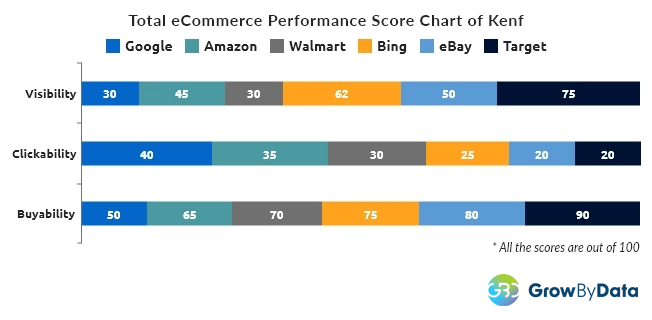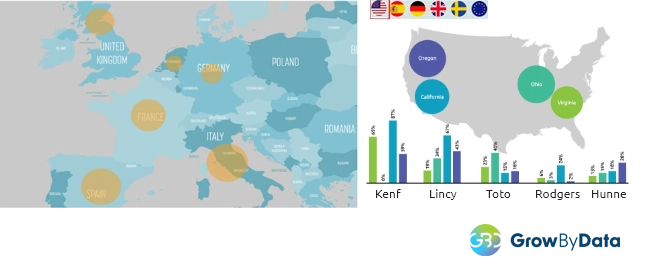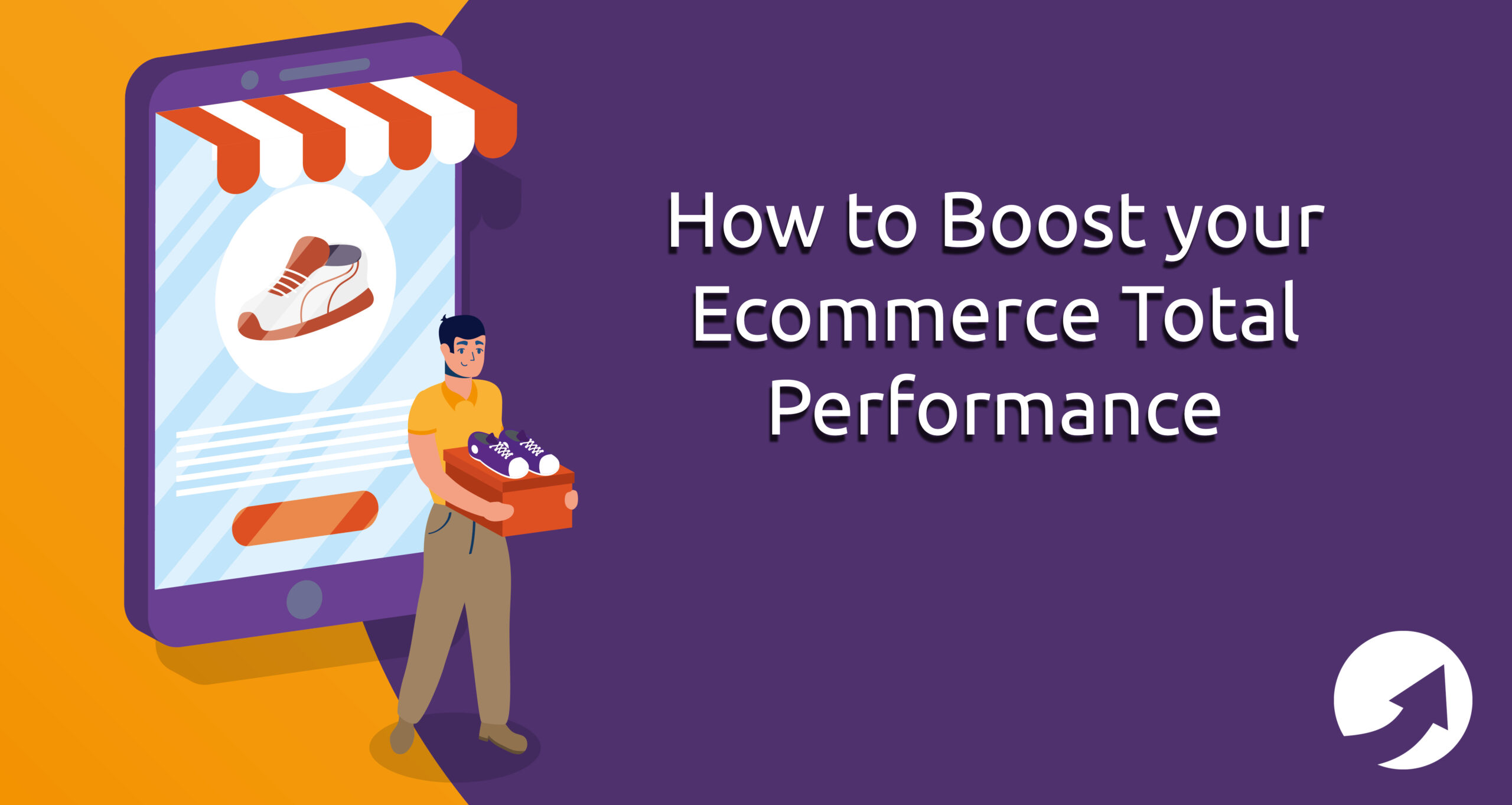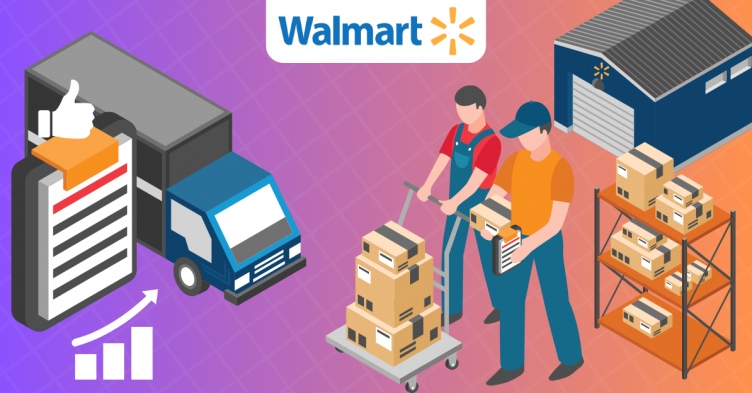Ecommerce total performance is the measure of visibility, click-ability, and buy-ability of your brand across Search platforms and marketplace channels. Typically, e-commerce managers and advertisers analyze these factors in silos and only rely on performance data from respective search and marketplace platforms. With unified intelligence across Search, Product, and Marketplace, GrowByData enables total performance visibility for smarter and faster e-commerce growth.
Unified insight into the visibility, click-ability, and buy-ability of your brand across channels helps both eCommerce managers and marketers to build an impactful marketing strategy and maximize total eCommerce performance with economic mileage.
Visibility is a measure of the Share of Voice across platforms. It allows you to analyze your and your competitors’ presence based on geo-visibility, seasonal visibility, keyword visibility, intent-based visibility, etc. The graph below shows that Kenf has good visibility on Target, but needs improvement on other platforms.
Click-ability is the measure of the usage of factors that influence the shopper to click on the product. Factors that relate to your click-ability are the optimization of title, images, product attributes, landing page(s), annotations, extensions, labels, special offers, promotions, discounts, etc. Per the graph below, this is another area that Kenf may need to look into improving.
Buy-ability is the measure of the product shopping experience. It is a quantitative measure of the features that will help you win the purchase once the shopper has clicked on the product. Per the graph below, Kenf has excellent buy-ability scores on Target and good scores on eBay, Bing, and Walmart. Having great visibility and buy-ability scores on Target means the product that is clicked on has a higher chance of purchase, but it also means that they may be losing out on sales by losing out on clicks to their competitors. The graph below shows the total performance of the brand Kenf.

With this unprecedented visibility at their fingertips, marketing intelligence empowers marketers to optimize their brand visibilities across Search platforms and Marketplaces, and maximize customer acquisition with lower cost and higher sales. Marketing intelligence also provides unified competitive intelligence across all digital shelves. All these market and competitive market insights help optimize your marketing budgets to maximize your target audience’s reach and improve clicks while boosting conversions and sales.
1. Cross Channel Visibilities Across the Shopper’s Journey
Having powerful intelligence for total e-commerce performance inevitably requires cross-channel visibilities across the shopper’s journey. Today, the shopper’s journey is complex, or as Google refers to it, the “messy middle”, moves through various channels in course of their complex e-commerce journey. Customers, starting from their “problem” identification stage, start looking for “solutions” (or products), through searches, and research using various “intent” actions through the different online search and marketplace channels, until they reach the final buying decision stage.
Therefore, as an e-commerce retailer depending upon your target audience size; it’s important to have visibility across popular search engines such as Google, Bing, etc, and Marketplaces such as Google Shopping, Amazon, Walmart, E-bay, Best Buy, Target, Instacart, CVS amongst others. With marketing intelligence, you can build and analyze intent-based visibility across the shopper’s journey, on all the major channels. The graph below shows the visibility of Kenf and its competitors in the apparel category, across several marketplaces. It showed that Kenf had a high share of voice on Walmart, a decent Share of Voice on Target and Bing, but poor visibility on eBay, Amazon, and Google.

In addition to being visible across Search channels and marketplaces, you also need to invest in content that speaks to audiences at different stages of the purchase journey. Generating and optimizing multiple pieces of content that address the informational needs of a shopper at different segments of the journey is almost a necessity to increase your Share of Voice in the ‘messy middle’. For example: searching for wireless headphones on Google gives a result like this:

Therefore, as a brand, it is important to not just try to get your website into the SERP, but it is vital to have content that is optimized to show up in multiple areas to increase the touchpoints with the digital shopper and thus increase your visibility.
2. Understanding Your vs. Your Competitors’ Brand Visibilities
Next, it is important to understand your versus competitors’ brand visibility and cross-channel visibility across the shopper’s journey. With marketing intelligence, you can understand the international, regional, city & postcode-level competitive landscape and your visibility across Search Engines & marketplaces. The visibility analysis based on location helps you narrow down your audience and focus your advertising to help find the right customers for your business.
Marketing intelligence also breaks down your locational visibilities into different product categories to understand which category has a better share of voice compared to your competitors.
With these deep analytics, you can gain a competitive edge over the competitors across time zones, target locations, channels, categories & seasons. You can mobilize your teams to set up and build your marketing strategies; while properly managing & utilizing your advertising budget to maximize your visibilities across the shopper’s journey, helping boost sales.

Also, if your target audiences use languages other than English, it is important to analyze their language-specific digital shelves. Based on the language, search queries, marketplace TLDs (top-level domain), and geo-locations might vary. GrowByData’s Marketing Intelligence monitors and analyzes your versus competitors’ total performance factors by languages and marketplaces.
![]()
3. Comprehensive Measure of Click-ability
Now you have an idea about your visibility and where you have a better Share of Voice, in comparison to your competitors. Whether you have good visibility or not, it is extremely important to analyze your click-ability factors. Typically, the reason you have less visibility is that you are not targeting the right location, or you have lower click-ability factors in your competitive landscape.
Marketing intelligence gives competitive visibility of click-ability factors and helps to analyze your optimization area to beat your competitors in both paid and organic digital shelves across channels.
- What are the Click-ability Factors in Digital Shelf?
There are many click-ability factors impacting your click-through rate and algorithmically your visibilities too. One way to analyze them in the Google Ad Platform is the Keyword Quality Score, measured on a scale from 1 to 10. Google has made this simplified with single metrics to understand your click-ability factors on its paid ad platform. Another important factor of this metric is the higher the quality score, the lower the Cost Per Click. Marketing intelligence gives a comprehensive outlook on your click-ability factors to describe vagueness brought by single metrics like Google Quality Score. With a granular analysis of ad content and the channel itself, marketing intelligence gives holistic visibility into your click-ability factors. - Ad Content Analytics:
A detailed view of the ad content performance across several channels in one view, like the graph below, gives a brand or advertiser a comprehensive picture. Insights include visibility into the use of reviews and ratings, annotations, extensions, shipping labels, tags, special promotions, etc. This information allows you to make the right decisions on what area or channel to increase/decrease resources.
Our tool has the capabilities to dive deeper into the attributes and brands on a keyword level as well. The graph below shows the match level between the searched keyword and the title of the ad for Reebok shoes. The level of match is quite different on various platforms.

- Holistically Analyze the SERP Component
Marketing intelligence gives you a holistic view of your brand’s performance across search engines and marketplaces. Having a complete view of your performance across the digital shelf allows you to build a unified plan to maximize your visibility. The table below shows the top 10 advertisers in the health category and where each of them ranks for different types of SERP components on Google.
4. Never Stop Improving Your Buy-ability Factors
Like click-ability factors boosting your visibilities, some factors impact your buy-ability, which influences your actual sales, and algorithmically has a tremendous impact on your visibility and click-ability across channels.
- Product Experience
The shopper’s journey is complex and messy, so it is important to have an excellent shopping experience throughout the buying decision process to boost your sales. Shoppers expect a user-friendly digital shelf that is convenient, personalized, and with an optimized product detail page. A powerful marketing intelligence tool comprehensively analyzes product contents across channels like Google, Amazon, Walmart, Target, etc., and provides you with a qualitative score of your product detail page, along with visibility into their competition scores, as shown in the table.
- Competitive Price
An important component of the product experience is to offer competitive prices across the channel. Competitive pricing is an important factor in winning the “Buy Box”. If your product is competitively priced, you are considered a good buying choice and you can win the Buy Box. Positioning your products in the Buy Box is the key to more impressions, clicks, and possibly sales. You need to keep track of competitors prices across marketplaces to make sure your prices are optimized and are dynamically competitive against your competitors so that you don’t lose out on traffic. Marketing intelligence shows you the pricing landscape of your product and category across marketplaces. Understanding your product’s price competitiveness allows you to create better dynamic pricing strategies to win more sales over your competitors.
Conclusion
For smarter and faster e-commerce growth, businesses need competitive analytics of their total performance factors. These unprecedented, unified insights into the visibility, click-ability, and buy-ability of your brand across channels help both eCommerce managers and marketers to build an impactful marketing strategy, and optimize and mobilize budgets to maximize total eCommerce performance with economic mileage.



